Scottish Health Survey 2016 - volume 1: main report
Statistics relating to the health of people living in Scotland.
8 Mental Health And Wellbeing
Alice Calder
Summary
- Average levels of wellbeing for adults, as measured by the Warwick-Edinburgh Mental Wellbeing Scale (WEMWBS), have remained stable since 2008, with scores ranging from 49.7 to 50.0 (49.8 in 2016).
- Reported mental wellbeing varied significantly by age with the highest mean WEMWEBS score reported for those aged 65-74 (50.8) and the lowest for those aged 45-54 (49.0).

- In 2016, 15% of adults exhibited signs of a possible psychiatric disorder (GHQ- 12 score of four or more), the proportion remaining relatively static since 2003.
- Ex-drinkers were most likely to have symptoms of a possible psychiatric disorder (28%), followed by non-drinkers (20%) and those drinking over 35 units per week (18%); those drinking within the recommended maximum of 14 units a week and those drinking between 14 and 35 units a week were the least likely (14% and 11% respectively).
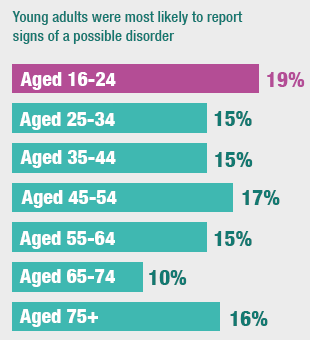
- The mean life satisfaction score for adults was 7.8 in 2016 (on a scale of 0-10).
- Adults aged 65-74 had the highest percentage of above average reported life satisfaction (41%), whilst those aged 45-54 had the highest percentage of below average life satisfaction (39%).
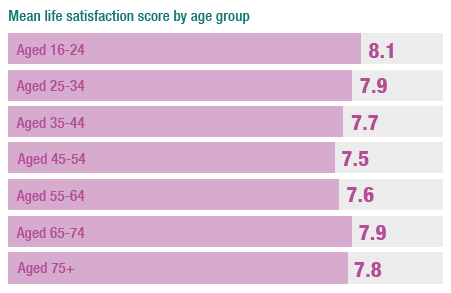
- Adults living in the most deprived areas reported lower life satisfaction and lower mental wellbeing than those in the least deprived areas (mean life satisfaction score was 7.3 in the most deprived areas, compared with 8.1 in the least; mean WEMWEBS scores were 47.4 in the most deprived areas, compared with 51.5 in the least).
8.1 Introduction
This chapter looks at the mental health and wellbeing of adults in Scotland. Mental wellbeing, together with physical and social wellbeing, is a central aspect of overall wellbeing. It is important as an indicator of quality of life. Like many of the other topics covered in this report, mental wellbeing is a critical measure of the population’s overall health status and a key marker of health inequalities[1].
The World Health Organisation (WHO) considers mental wellbeing to be fundamental to their definition of health[2]. Mental disorders often co-exist with other diseases, including cancers and cardiovascular disease[3], and many of the risk factors covered in this report, such as obesity, excessive alcohol consumption, and low levels of physical activity, are common to both mental disorders and other non-communicable diseases, with outcomes being critically interdependent.
Mental disorder represents a significant public health challenge globally. Adolescence and early adulthood is the peak age of onset for mental ill-health and the period when initial care is required[4]. Those with mental disorders have disproportionately higher disability and mortality than the general population, dying on average more than 10 years earlier[5]. Neuropsychiatric disorders are the second largest contributor to the burden of disease in Europe and mental disorders account for around 40% of all years lived with disability[5]. Accounting for 4.3% of the global burden of disease, depression is now the largest single cause of disability worldwide (11% of all years lived with disability globally) and is the leading chronic condition in Europe[2]. Mental health is affected by the same inequalities as physical health and is strongly associated with poverty and social exclusion[6]. Globally, depression is more prevalent among women than men[2] as well as marginalised groups[7].
8.1.1Policy background
In March 2017 the Scottish Government published a new 10 year Mental Health Strategy: 2017-2027[5]. The new strategy is one of many measures to help create a Fairer Scotland[8]. The guiding ambition for this new strategy is parity of esteem, that is, to prevent and treat mental health problems with the same commitment, passion and drive as is given to physical health problems. In recognition of the evidence of the personal and societal costs of failing to prioritise mental health and wellbeing, the strategy is focussed on prevention, early intervention and physical wellbeing, equal access to safe and effective treatment and joined up accessible services. Addressing higher mortality and smoking rates amongst those who experience mental illness is a priority as well as improving their access to physical health care. Additional themes in the Strategy include ensuring protection and promotion of rights, better information use and planning. The importance of improving measurement of outcomes in mental health is emphasised, to include not just data on service activity but also on effect and the experience for people.
The strategy contains 40 initial actions including additional funding to increase the mental health workforce across a wide range of settings, these include:
- Improving out of hours and urgent access to mental health care and treatment.
- Evaluating primary care transformation projects that are exploring new models of multi-disciplinary primary care mental health delivery.
- Evaluating Distress Brief Interventions.
Underpinning these actions is a commitment to tackle mental health inequalities and embed a human-rights based approach across services with high aspirations for service users.
There is also emphasis on improving support and services for children and young people, including those who come into contact with the criminal justice system. The Scottish Youth Parliament campaign for 2016 ‘Speak Your Mind’ highlighted the importance of mental wellbeing as a policy priority for young people in Scotland[9].
A range of government departments (including poverty, education, justice, social security and employment) are expected to support the implementation of the strategy and a bi-annual forum of mental health stakeholders will help steer implementation. A measurement framework will be developed to track progress towards parity and illustrate broader population mental health. A quality indicator profile will gather data balanced across the quality dimensions to illustrate service delivery. It is intended that the roll out of this framework and profile will occur in a phased way over 3 years with the parallel retiring of data collection and reporting that is made redundant by the process. SHeS will contribute to these developments.
The 2017-2027 strategy builds upon a number of key policy documents including the Mental Health Strategy for Scotland: 2012-2015[5], which promoted more person-centred and effective mental health services, emphasising self-management and community support. This was preceded by Towards a Mentally Flourishing Scotland, (2009-2011), and Delivering for Mental Health[11] (published in 2006) where the aim was to promote mental wellbeing for the public and those experiencing mental health problems alongside reducing the prevalence of common mental health problems, suicide and self-harm.
One of the Scottish Government's National Outcomes is the overall strategic objective for health: We live longer, healthier lives[12]. This is supported by a number of National Indicators including 'improve mental wellbeing’[12] which is monitored using data from the Scottish Health Survey (SHeS). The purpose target to improve healthy life expectancy over the 2007 to 2017 period uses SHeS data in the calculations used to measure progress. Given that those with mental disorders die, on average, earlier than the general population, mental health impacts on another National Indicator; to ‘reduce premature mortality’. Scotland also has a set of national, sustainable mental health indicators for adults and children, covering both outcomes and contextual factors that confer increased risks of, or protection from, poor mental health outcomes[13]. SHeS is the data source for 28 of the 54 indicators for adults[14] and over 20 of the indicators for children[15].
There were NHS Scotland HEAT targets for specialist Child and Adolescent Mental Health Services (CAMHS), and for access to Psychological Therapies (across all ages in the population), to achieve 18 week maximum referral to treatment times[16]. In January 2015, the targets became standards in NHS Scotland Local Delivery Plans[17].
Figures for the quarter ending March 2017 show that the target was met for 84% of referrals of children and young people[18]. Around 74% of patients (across all ages) starting a psychological therapy met the target during the quarter ending March 2016[19]. The Scottish Government has announced additional funding to continue to improve mental health across Scotland and ensure that people get timely access to services.
8.1.2 Reporting on mental wellbeing in the Scottish Health Survey (SHeS)
This chapter updates trends in mental health and wellbeing for adults. Figures are also reported by age and sex and area deprivation. Age-standardised GHQ-12 scores are reported by levels of alcohol consumption.
The area deprivation data are presented in Scottish Index of Multiple Deprivation (SIMD) quintiles. To ensure that the comparisons presented are not confounded by the different age profiles of the quintiles, the data have been age-standardised. Readers should refer to the Glossary at the end of this Volume for a detailed description of both SIMD and age-standardisation.
Supplementary tables on mental wellbeing are also published on the Scottish Health Survey website[20].
8.2Methods and definitions
8.2.1Warwick-Edinburgh Mental Wellbeing Scale (WEMWBS)
Wellbeing is measured using the WEMWBS questionnaire. It has 14 items designed to assess: positive affect (optimism, cheerfulness, relaxation) and satisfying interpersonal relationships and positive functioning (energy, clear thinking, self-acceptance, personal development, mastery and autonomy)[21]. The scale uses positively worded statements with a five-item scale ranging from ‘1 - none of the time’ to ‘5 - all of the time’. The lowest score possible is therefore 14 and the highest score possible is 70; the tables present mean scores.
The scale was not designed to identify individuals with exceptionally high or low levels of positive mental health so cut off points have not been developed[22]. The scale was designed for use in English speaking populations, however in a very small number of cases the questions were translated to enable the participation of people who did not speak English[23].
WEMWBS is used to monitor the National Indicator ‘improve mental wellbeing’[12]. It is also part of the Scottish Government’s adult mental health indicator set, and the mean score for parents of children aged 15 years and under on WEMWBS is included in the mental health indicator set for children[13].
8.2.2 General Health Questionnaire 12 (GHQ 12)
GHQ-12[24] is a widely used standard measure of mental distress and mental ill-health consisting of 12 questions on concentration abilities, sleeping patterns, self-esteem, stress, despair, depression, and confidence in the previous few weeks. Responses to each of the GHQ-12 items are scored, with one point allocated each time a particular feeling or type of behaviour is reported to have been experienced 'more than usual' or 'much more than usual' over the previous few weeks.
These scores are combined to create an overall score of between zero and twelve. A score of four or more (referred to as a high GHQ-12 score) has been used here to indicate the presence of a possible psychiatric disorder. A score of zero on the GHQ-12 questionnaire can, in contrast, be considered to be an indicator of psychological wellbeing. GHQ-12 measures deviations from people's usual functioning in the previous few weeks and therefore cannot be used to detect chronic conditions.
8.2.3 Life satisfaction
Life satisfaction is measured by asking participants to rate, on a scale of 0 to 10, how satisfied they are with their life in general. On the scale, 0 represented 'extremely dissatisfied' and 10 'extremely satisfied' (the intervening scale points were numbered but not labelled). This measure has been used in numerous international surveys. There are no pre-defined cut-off points within the scale to distinguish between different levels of satisfaction. However, a summary measure was used in this analysis which identified three groups of interest based on the overall distribution of scores in the whole population: people with the highest levels of satisfaction (scores of 9 or 10), people with an average satisfaction level (score 8), and those with below average scores (0-7).
8.3 Warwick-Edinburgh Mental Wellbeing Scale (WEMWBS)
8.3.1Trends in adult WEMWBS mean scores since 2008
WEMWBS mean scores for all adults aged 16 and over have remained relatively stable since 2008, with scores ranging from 49.7 to 50.0 (49.8 in 2016).
WEMWBS mean scores have not significantly varied between men and women since 2008, with the mean score in 2016 for both sexes being 49.8.
8.3.2Adult WEMWBS mean scores in 2016, by age and sex
For all adults, the WEMWBS mean score varied significantly by age with the highest score for those aged 65-74 (50.8) and the lowest for those aged 45-54 (49.0).
Levels of wellbeing differed by age for women with the lowest WEMWBS mean score amongst those aged 45-54 (48.8) and the second lowest score being for those aged 16-24 (49.1). This represents a significant change from 2015 when women aged 16-24 had the lowest WEMWEBS mean score at 47.9. In 2016, the highest mean score for women was amongst those aged 65-74 (51.2). There was no significant variation across the age groups for men.
Figure 8A, Table 8.2
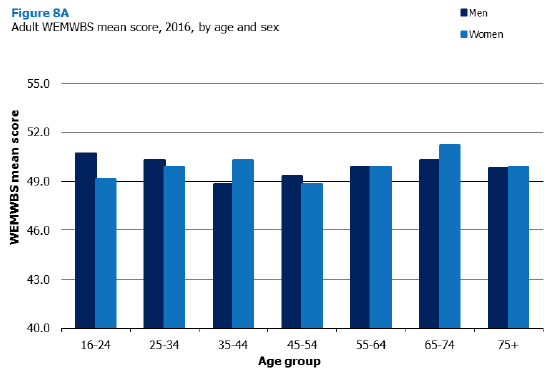
8.3.3 WEMWBS mean scores in 2016, by area deprivation and sex
As area deprivation increased, the age-standardised WEMWBS mean score decreased. Among adults, the mean age-standardised WEMWBS score for the least deprived areas was 51.5 compared with the most deprived areas with a mean score of 47.4. A similar pattern was seen for both men and women. For women the mean scores ranged from 47.1-52.2 and for men the mean scores ranged from 47.7-50.9.
Figure 8B, Table 8.3
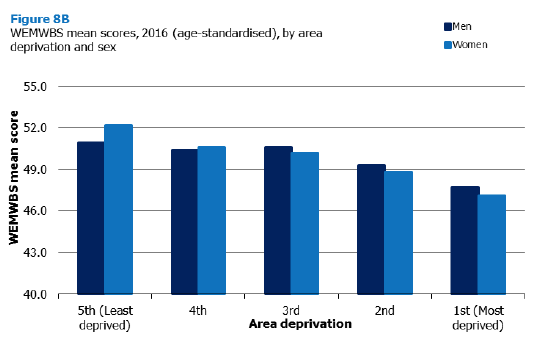
8.4 General Health Questionnaire 12
8.4.1Trends in GHQ-12 scores since 2003
For all adults, GHQ-12 scores remained relatively static between 2003 and 2016. In 2016, 15% of adults (16 and over) had a GHQ-12 score of four or more (indicating a possible psychiatric disorder). In 2016, 61% of adults reported a GHQ-12 score of zero (indicating good psychological wellbeing with no symptoms of mental distress evident).
More men (65%) had GHQ-12 scores of zero, than women (58%) in 2016. This is typical of the pattern since 2003, where a consistently higher proportion of men than women had GHQ-12 scores of zero. Correspondingly, from 2003 to 2016, women were significantly more likely than men to have a GHQ-12 score of 4 or more. In 2016, 17% of women reported symptoms of a possible psychiatric disorder (GHQ-12 score of 4 or more), compared with 13% of men.
8.4.2 GHQ-12 scores in 2016, by age and sex
GHQ-12 scores differed significantly by age. In 2016, the highest percentage (19%) of GHQ-12 scores of four or more was found among adults in the 16-24 age group. In contrast, the 65-74 age group had the lowest percentage of adults with GHQ-12 scores of four or more (10%) and the highest percentage with a GHQ-12 score of zero (69%). Similar patterns were found for both men and women.
Overall a higher percentage of women than men had a GHQ-12 score of four or more (17% compared with 13%); rates were higher for women across all age groups, see Figure 8C. For women, the highest percentage with GHQ-12 scores of four or more was found among those aged 45-54 (21%), closely followed by the those aged 16-24 (20%). For men, the highest percentage with GHQ-12 scores of four or more was found among those aged 16-24 (18%).
Figure 8C, Table 8.5
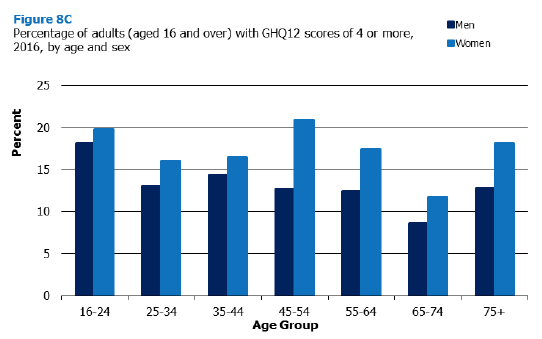
8.4.3 GHQ-12 scores (age standardized), 2013-2016 combined, by alcohol consumption and sex
For the purposes of Table 8.6, alcohol consumption has been categorised as follows: non-drinker (no alcohol units per week); ex-drinker (no longer drink alcohol); moderate (>0 units and up to 14 units); hazardous (>14 units and up to 35 units); harmful (> 35 units).
Of all adults, those self-reporting as ex-drinkers were the most likely to have a GHQ-12 score of four or more (28%), followed by non-drinkers (20%) and those drinking at a harmful level (18%). Moderate and hazardous drinkers were the least likely to have a GHQ-12 score or more (14% and 11% respectively). . The same pattern was found for both men and women, although the differences between drinking categories were more pronounced for women than for men.
Those drinking at a hazardous level were more likely than those in any other drinking category to report a GHQ-12 score of zero (67%) whilst ex-drinkers had the lowest percentage of GHQ-12 scores of zero (45%). A similar pattern was found among both men and women.
These data should be interpreted with caution. The patterns do not indicate a causal relationship between the amount of alcohol consumed and mental health and merit further exploration. In particular, the reasons for non-drinking and ex-drinking behaviour should be explored as some may be related to ill health, implying reverse causality which could occur when people stop drinking after developing symptoms of a psychiatric or other disorder.
8.5 Life Satisfaction
8.5.1 Life satisfaction scores in 2016, by age and sex
The average mean life satisfaction score for adults was 7.8, remaining unchanged since last reported in 2014. There was no significant difference in mean life satisfaction between men and women.
In 2016 approximately a third of all adults fell into each of the following life satisfaction categories: 34% reported the highest level of life satisfaction (scores of 9 or 10), 33% reported average life satisfaction (score 8), and 34% reported below average life satisfaction (scores of 0-7). Overall more women reported an above average life satisfaction than men (35% compared to 32%).
Mean life satisfaction scores were highest for those aged 16-24 (8.1) and lowest among those aged 45 to 54 (7.5) rising to 7.8-7.9 for those aged 65 and over. Similar patterns were found for men and women, see figure 8.D.
Those aged 45-54 also had the highest percentage of adults with below average life satisfaction scores (39%). The 65-74 age group had the highest percentage of adults reporting an above average life satisfaction (41%), closely followed by the youngest and oldest age groups (37% among those aged 16-24 and 36% for those aged 75 and over).
Figure 8D, Table 8.7
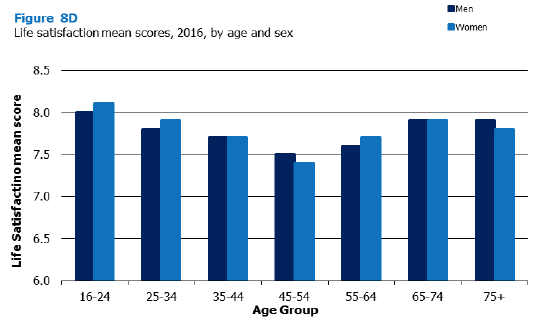
8.5.2 Life satisfaction scores in 2016, by area deprivation and sex
There was a clear social gradient in life satisfaction; people in the most deprived areas tended to have a lower life satisfaction than those in the least deprived areas (age-standardised mean life-satisfaction scores of 7.3 and 8.1 respectively in 2016). The same pattern was found for life satisfaction categories. A higher proportion of adults in the least deprived areas reported an above average life satisfaction (40%) compared with adults in the most deprived areas (26%). Similar patterns were found for both men and women.
As shown in Figure 8E, women in the least deprived areas had a higher level of above average life satisfaction than men (44% vs 35%).
Figure 8E, Table 8.8
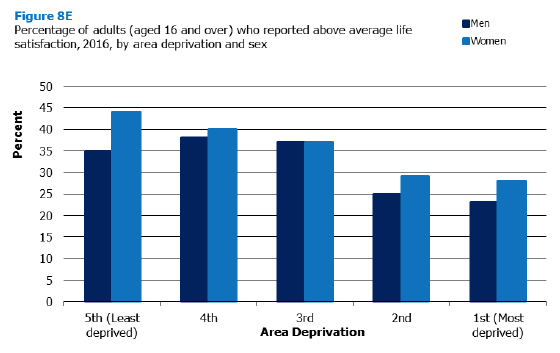
Contact
Email: Julie Landsberg, Julie Landsberg
Phone: 0300 244 4000 – Central Enquiry Unit
The Scottish Government
St Andrew's House
Regent Road
Edinburgh
EH1 3DG
There is a problem
Thanks for your feedback
